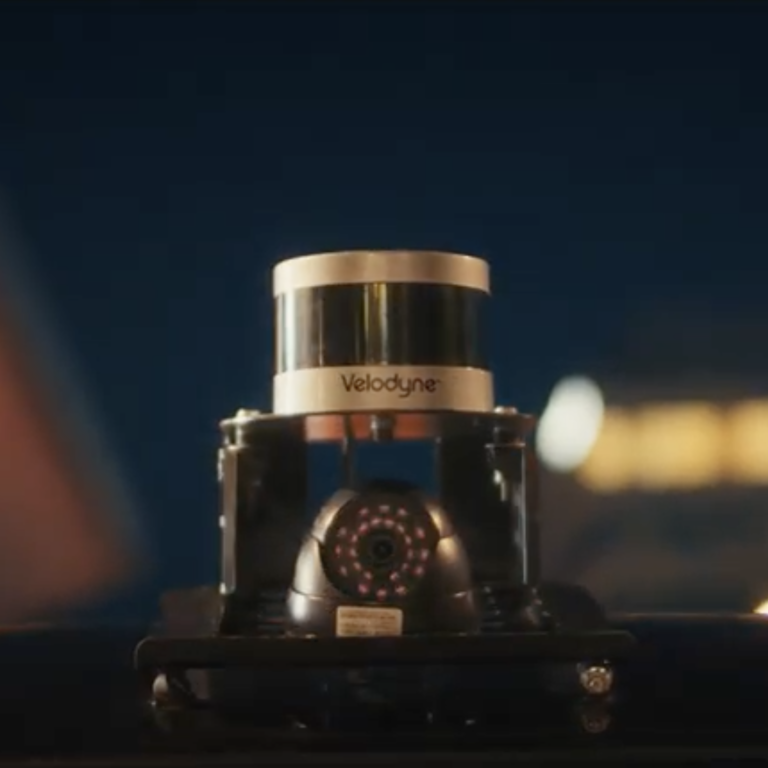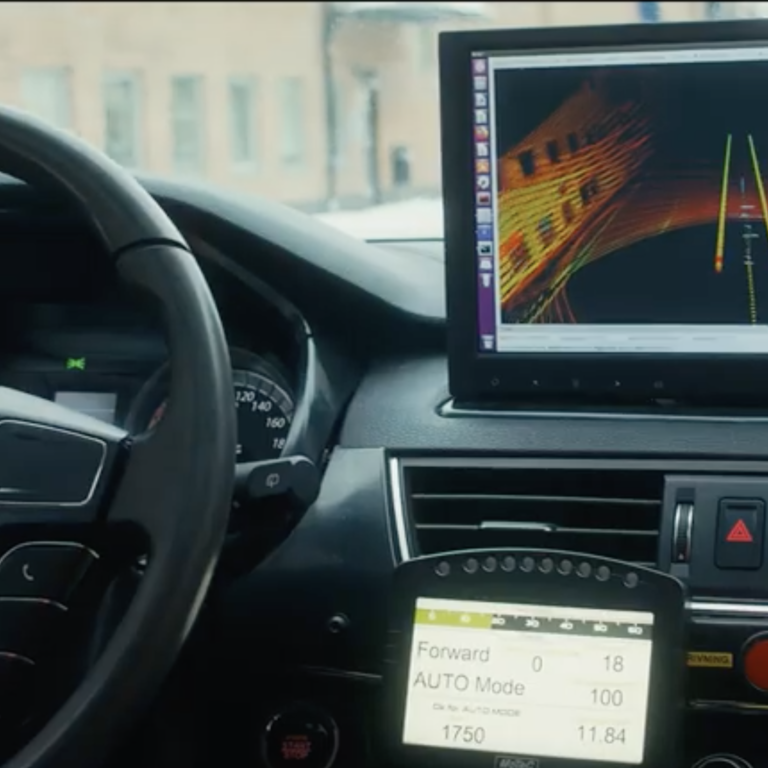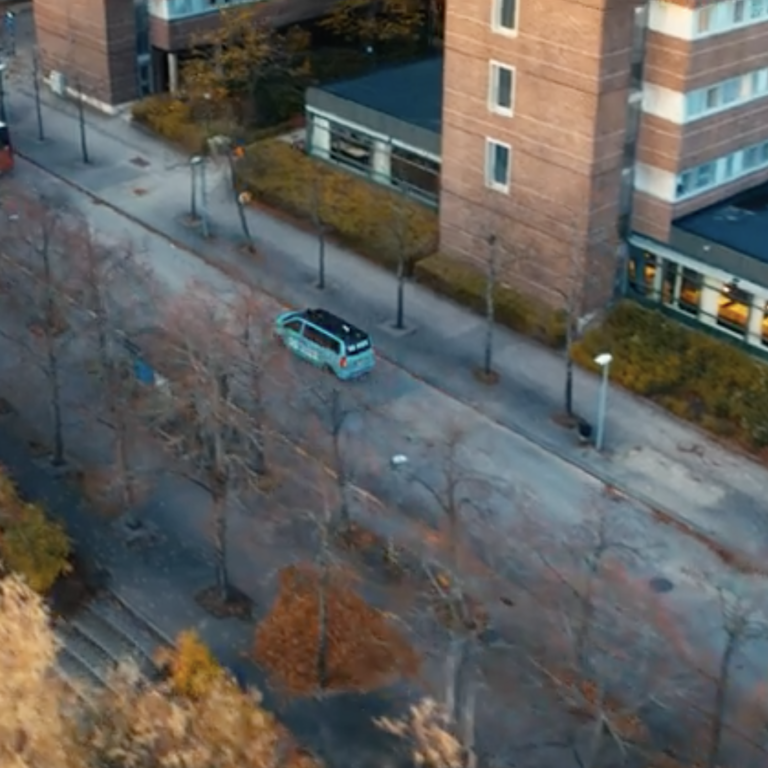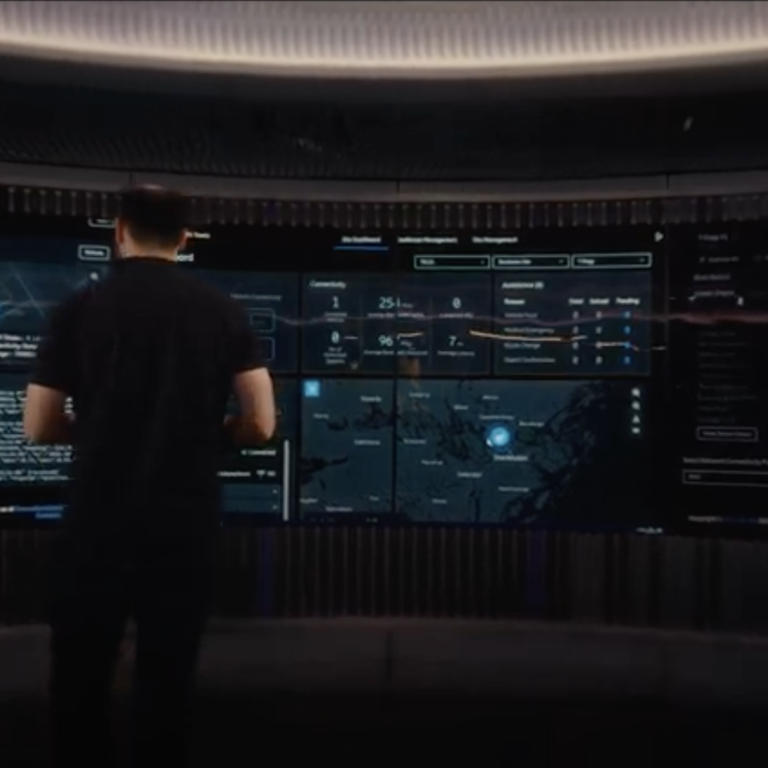5G Transformation Hub
Self-driving buses supported by 5G
5G Ride, a connectivity-based solution that supports autonomous self-driving buses
5G Ride is a collaboration project between Ericsson, Intel, Keolis, T-Engineering, Telia Company, KTH (The royal institute of technology), Region Stockholm led by Kista Science City Urban ICT Arena (a collaboration arena for creating, testing and showing the solutions for tomorrow’s sustainable cities), Scania and Viscando. The project focuses on efficient and sustainable public transport through the use of 5G technology to enable self-driving electric vehicles in urban areas.
Select a project
Contents
Challenge
The main challenge for the 5G Ride is to remove the driver from the vehicle and provide oversight of the entire system from the control tower. It requires extremely high data transfer speed to enable buses to respond in real-time to commands. In addition the vehicles need to understand the surrounding environment using AI capabilities and an array of sensors to make immediate decisions while operating autonomously. Given these challenges autonomous buses required access to low latency and high capacity data transfer between the vehicle and the control tower. Moreover the data needs prioritising in the network so that when one vehicle faces an obstacle and achieves a solution, the data can be shared with another vehicle instantly to enhance safety and security in case of the unexpected.
Solution
The 5G autonomous mini-buses are provided by T-engineering and use Ericsson’s radio equipment to connect via Telia’s 5G network with automated transportation control software and staff in a control tower. Intel delivered analytics capabilities and the technology for data processing across the network including in the vehicles and the control tower, as well as the mobile network.
Impact & Statistics
The solution is expected to optimise route planning and traffic in the city of Stockholm. Running on renewable energy, the vehicle can solve issues with congestion, air quality, and carbon emissions. The trial found that the cost of operating automated public transport is roughly half that of an equivalent service with drivers. Additionally, if one driver operates several vehicles the bus operator can dedicate available resource to vehicles travelling in more complex environments (such as traffic intersections or unsafe areas) to provide better services.
Wider Implications
Self-driving technology combined with electrification and 5G can make public transport more efficient to operate and more accessible to users while reducing the environmental footprint. The technical features of 5G are well suited for real-time monitoring and control of operations and in this case they play a significant role in enabling automated mobility. 5G allows vehicle-to-everything (V2X) communication and the vehicle can sense pedestrians, stoplights and other cars and is able to take real-time decisions to apply brakes, accelerate or steer where necessary.
Stakeholders
Ericsson, Intel, Keolis, T-Engineering, Telia Company, KTH (The royal institute of technology), Region Stockholm led by Kista Science City Urban ICT Arena (a collaboration arena for creating, testing and showing the solutions for tomorrow’s sustainable cities), Scania and Viscando.
02
Self-driving buses supported by 5G
5G Ride, a connectivity-based solution that supports autonomous self-driving buses
Cities in the future are likely to benefit from digitisation and new technologies making them smarter and more sustainable and improving and simplifying life for citizens. Autonomous electric buses are likely to become an essential part of many smart city projects and can help meet the demand for a smart transport system. 5G Ride in Stockholm demonstrates the use-case for a smart bus transportation in a smart city project.
The project plan was laid down in 2019 by Kista Science City in collaboration with Ericsson and Keolis. The development and testing of a 5G assisted autonomous vehicle was undertaken in 2020, with Telia’s 5G network, Intel supporting AI on-board vehicles. A trial of 5G Ride took place in 2020, testing self-driving electric and 5G-enabled vehicles in traffic in Royal Djurgården, Stockholm. Testing and trial activities were undertaken in a fenced area using AI and remote driving with an on-board support driver for safety and security. In the two-week pilot program, AV provider T-Engineering connected minibuses to Telia’s 5G communication network, powered by Ericsson radio equipment (operating in the 700 MHz band).
The minibuses are smart driverless vehicles equipped with 5G connectivity and AI capabilities that can check their surroundings using an array of sensors including lidar, radar and optical sensors. The solution demonstrates how real-time data from within an autonomous vehicle can be transmitted to a centralised supervision or control tower and how, in return, the vehicle can respond to commands with the support of an AI system and high speed 5G network. Additional data collected by cameras located on the buses allows for counting passengers and tracking any items that passengers might leave behind on the bus. Any lost items are signalled to passengers using outboard microphones. The system also detects any abnormal passenger behaviour and informs the supervision tower if it detects that somebody might potentially be unwell. The operator in the supervision tower can then take immediate action by calling a doctor or an ambulance.
Initially, 5G Ride has been tested carrying passengers to two popular attractions (the Biological Museum and Rosendal Castle) in Stockholm, Sweden, as part of a two-week pilot project. The aim is to pave the way towards making 5G-enabled electric driverless public transport services a reality as a smart, efficient and sustainable transport solution.
Over the second phase, in 2022, the pilot focused on enhancing situational awareness for buses by deploying sensors in infrastructure such as traffic lights and other street furniture. The additional sensors help the 5G Ride system to better analyse the environment, traffic situation and other road users. In particular, sensors at road junctions and intersections can help on-board systems to ‘see’ oncoming vehicles around corners by using data collected from available vantage points. An alternative approach to reducing similar risks would be to replace an intersection with a roundabout which is a far more costly alternative.
In all cases, vehicles are programmed to stop in situations that cannot be safely handled by either on-board systems or remote staff in the control tower.

03
5G to enhance scalability, security and performance
5G enables low latency and high-capacity communications, which are two crucial features required to manage driverless vehicles in real-time
Another key feature supported through AI and 5G includes data sharing amongst the vehicles. For instance when one vehicle identifies a good solution to an unexpected traffic situation relevant information can be shared with other vehicles instantly. In case any passenger requires remote assistance, staff in the command centre are able to intervene. The command center or traffic tower plays a key role in assisted driving, passenger support, continuous ride monitoring and managing alarms and potentially coordinating with rescue services.
A key aspect of the command centre arrangement is that passengers are aware that a remote authority is monitoring the local situation and ready to provide assistance when needed. In traditional public transport scenarios, such a role is typically played by the driver who can give passengers a sense of safety and security.

04
Optimising route planning and enhancing sustainability
The solution is an example of how 5G can benefit society. Self-driving technology combined with electrification and 5G helps transform public transport, making it operationally efficient and accessible to users and so reducing the environmental footprint of smart city transportation.
Additionally, the more fluid traffic flows that can be achieved with optimised autonomous vehicles result in reduced tire wear, reduced wear on the road infrastructure and extended maintenance intervals for the buses. Energy consumption can be reduced, traffic can become safer and the experience of using public transport can be more pleasant.
“To solve our problems with congestion, air quality and climate emissions in Stockholm, we need many different transport solutions. We are positive to these types of pilot projects because we believe that the vehicle of the future is autonomous, electric and easy to share, and this autonomous electric bus is a perfect example of that.” said Daniel Helldén, Vice Mayor of Traffic in Stockholm
Vehicle routing can also be optimised with the introduction of flexible bus schedules that can be altered depending on passenger demand, including the potential to divert more bus capacity to where it is needed. This can be particularly beneficial in rural areas and can enable public transport systems to extend into locations that were previously economically unviable.

05
Next Steps – Running trials without a safety driver on board
Keolis, Region Stockholm and the ICT companies plan to again run a trial for the driverless buses in 2023 with the trial extending to include an urban area. In 2024, tests will focus on situation awareness. New collaborations have been added with Viscando (a 3D and AI sensing platform for traffic analytics) and Scania (a vehicle manufacturer).
As a part of 5G Ride, the pilot also simultaneously tested ‘Delta’, a last-mile public transport project in Kista. The solution explores the potential for on demand last mile-solutions as a part of public transport. During the test, electric cars booked by users through a mobile application took riders from door to door and connected public transit hubs with destinations within Kista. Through the on-demand application, the aim is to test and understand customer needs and motivation to choose Delta over other first/last mile mobility solutions (such as micro mobility) and private cars and observing user experience through the test results.

06
About
About the GSMA
The GSMA is a global organisation unifying the mobile ecosystem to discover, develop and deliver innovation foundational to positive business environments and societal change. Our vision is to unlock the full power of connectivity so that people,
industry, and society thrive. Representing mobile operators and organisations across the mobile ecosystem and adjacent industries, the GSMA delivers for its members across three broad pillars: Connectivity for Good, Industry Services and Solutions, and Outreach. This activity includes advancing policy, tackling today’s biggest societal challenges, underpinning the technology and interoperability that make mobile work, and providing the world’s largest platform to convene the mobile ecosystem at the MWC and M360 series of events.
For more information, please visit the GSMA corporate website at www.gsma.com.
Follow the GSMA on Twitter: @GSMA.
GSMA 5G Transformation Hub
The GSMA 5G Transformation Hub is a source of information on some of the most innovative 5G solutions in the world. This portal contains case studies detailing design, benefits, key players, measured value and the future impact of scaling up these 5G solutions worldwide. The 5G Era is now firmly established and this family of standardised GSM technologies, including mmWave, are being rolled out successfully across the globe. The GSMA 5G Transformation Hub, launched at MWC Barcelona in 2022, provides details of how 5G is best placed to deliver real value for a range of key sectors including manufacturing, energy, transportation, media and live entertainment, smart cities and construction. Many more case studies will be added, in the coming months, covering even more industries and the GSMA is asking Members to nominate innovative 5G case studies to add to this global digital showcase. The 5G Transformation Hub and this particular Case Study are both sponsored by Qualcomm.
About this case study
This case study is for information only and is provided as is. The GSM Association makes no representations and gives no warranties or undertakings (express or implied) with respect to the study and does not accept any responsibility for , and hereby disclaims any liability for the accuracy or completeness or timeliness of the information contained in this document. Any use of the study is at the users own risk and the user assumes liability for any third party claims associated with such use.